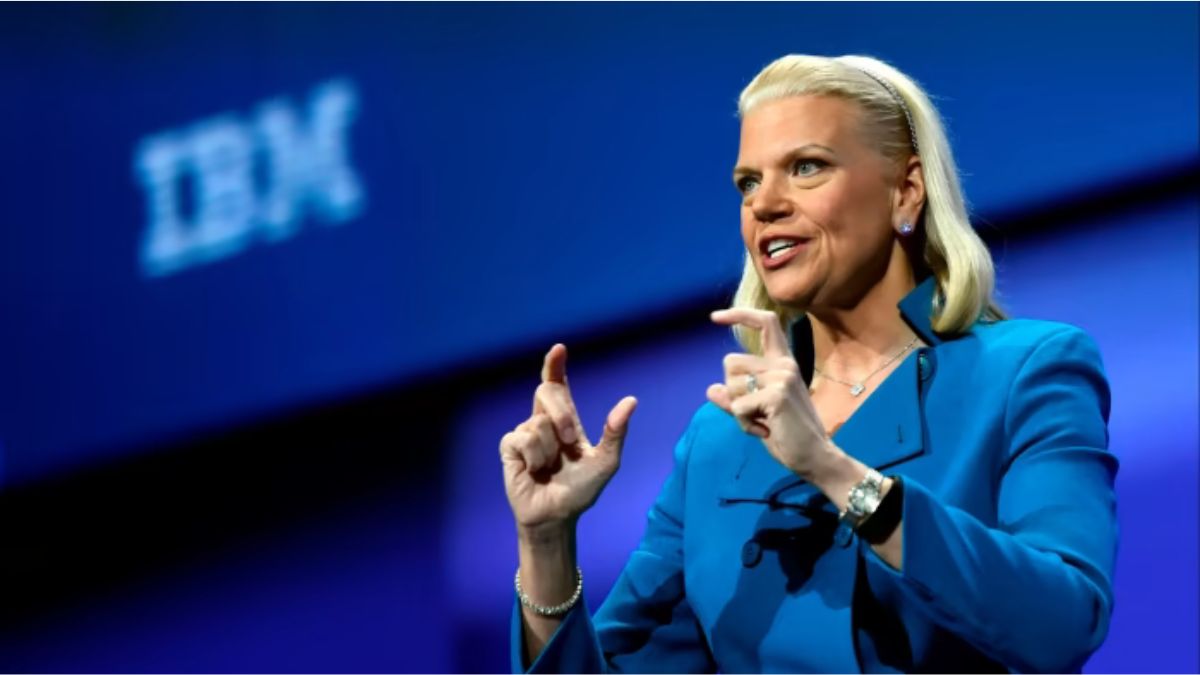Ginni Rometty, a prominent American businesswoman renowned for her innovative leadership in the technology sector, was born Virginia Marie Rometty in Chicago, Illinois, on July 29, 1957. As the first female chairman, president, and chief executive officer of IBM, one of the biggest and most recognisable technology firms in the world, she created history. Rometty’s ascent to the top of IBM is a tale of tenacity, inventiveness, and the value of tenacity in a business environment that is constantly changing.
Early Life and Education
A middle-class family in the Chicago suburbs is where Rometty’s narrative starts. Growing up in a humble family, Rometty showed a keen interest in education early on. Her mother, a homemaker, and father, a businessman, fostered a work ethic and discipline in the Rometty home. Ginni had a special interest in mathematics, which would play a major role in her future profession.
Rometty’s scholastic path took her to Northwestern University, where she studied electrical engineering and computer science. She first became interested in technology and business while she was a university student. Her technical proficiency and innate leadership skills paved the way for a career that would transform the company. She graduated with honours in 1979, kicking off a long and illustrious career in business.
Early Career
After graduation, Rometty began her professional career as a systems engineer with General Motors. Rometty’s early positions were technical, but her innate leadership talents quickly shined through. She rapidly realised that her genuine interest was not only solving complicated challenges, but also inspiring others to innovate and create change. This realisation encouraged her to change into management positions.
Rometty joined IBM in the mid-1980s, starting off as a systems engineer. This is where her career really took off. Rometty has held a variety of jobs throughout the years, overseeing significant efforts that have established her as one of IBM’s most promising executives. She worked across multiple business areas, establishing a reputation as a forward-thinking CEO capable of making difficult decisions. Her most noteworthy early achievement was leading IBM’s acquisition of PricewaterhouseCoopers’ consulting division in 2002. The $3.5 billion transaction was a game changer for IBM, converting it from a hardware manufacturer to a global leader in technology consulting and services.
Rising Through the Ranks
Rometty’s career at IBM was distinguished by a series of strategic choices that demonstrated her capacity to lead while also envisioning the future of technology. In the mid-2000s, she became a key architect of IBM’s transition, as the firm switched its emphasis from traditional hardware to services, software, and cloud computing. Rometty was key in steering IBM’s strategy towards high-value areas including data analytics, cloud computing, and cognitive computing. Her leadership was important in IBM’s expansion into new areas, and she continually shown an ability to predict the next big thing in technology.
Rometty’s hard work and vision paid off in 2011, when she was appointed CEO of IBM, a position she would retain until 2020. As CEO, Rometty’s leadership style was distinguished by an emphasis on innovation, restructuring, and a desire to transform IBM into a more nimble, forward-thinking corporation. She embraced the cloud revolution and made significant investments in artificial intelligence and machine learning, both of which were regarded as important to the future of technology.
Leading IBM to the Future
As CEO, Rometty faced a number of internal and external problems. IBM was dealing with a shifting business climate, with competitors such as Google, Microsoft, and Amazon rapidly reshaping the technology industry. To assure IBM’s future relevance, Rometty implemented a number of daring policies, including significant investments in cloud computing and AI through acquisitions such as Red Hat in 2019. This $34 billion acquisition was one of IBM’s largest in history, and it was a vital step towards establishing IBM as a leader in hybrid cloud computing, an area where Rometty saw enormous growth potential.
Under her tenure, IBM made great progress towards becoming a more service-oriented company. The company’s concentration on data and artificial intelligence became fundamental to its long-term strategy, with Rometty emphasising the need of IBM taking the lead in the development of cognitive technologies, such as Watson. IBM’s Watson platform garnered headlines for its achievements in healthcare, finance, and education, and Rometty was a strong champion for leveraging technology to address some of the world’s most serious issues.
However, Rometty’s stint as CEO was not without obstacles. Despite her strategic vision, the corporation encountered significant challenges in implementing its change. For several years, IBM’s income dropped, and detractors questioned the company’s migration to cloud computing. Despite these setbacks, Rometty remained confident that the company’s change was the right path. She was noted for her calm demeanour and thorough approach to leadership, never letting external pressures influence her decisions.
Leadership Philosophy
One of Rometty’s primary leadership characteristics was her emphasis on diversity and inclusiveness. Throughout her career, she has been a passionate supporter of gender equality and women in leadership positions. Rometty, as one of the most renowned female CEOs in the IT business, established herself as a role model for women seeking to enter into traditionally male-dominated fields. She also prioritised developing a working culture that emphasised creativity, innovation, and cooperation.
Rometty’s leadership philosophy was also founded on the belief that technology should be used to enhance the world. Her strong confidence in the power of AI and data to tackle complex global challenges fuelled many of IBM’s main efforts throughout her tenure. She was a passionate advocate for using cognitive computing to tackle issues such as climate change, healthcare disparities, and education gaps. For Rometty, technology was not just about profit—it was about progress.
Legacy and Impact
When Rometty stepped down as CEO in 2020, she left a corporation that had undergone substantial transformation. IBM’s focus on cloud computing, artificial intelligence, and cognitive technologies was reinforced, positioning the business for future success. Her decision to stand down was a watershed moment for the corporation, signalling the end of an era of leadership defined by Rometty’s creative approach to technology.
Ginni Rometty’s career has been filled with both successes and tribulations, but she has always been a steadfast leader. Her ability to lead one of the world’s largest and most established corporations during periods of significant upheaval demonstrates her resilience and insight. Her legacy includes not only business success, but also encouraging others, particularly women, in the tech industry.
Today, Rometty is a respected figure in the digital industry, advising startups and organisations on the future of business and technology. Her narrative demonstrates the power of dedication, vision, and leadership to shape the future.
Also read: Women’s Transformative Role in the Digital Economy










